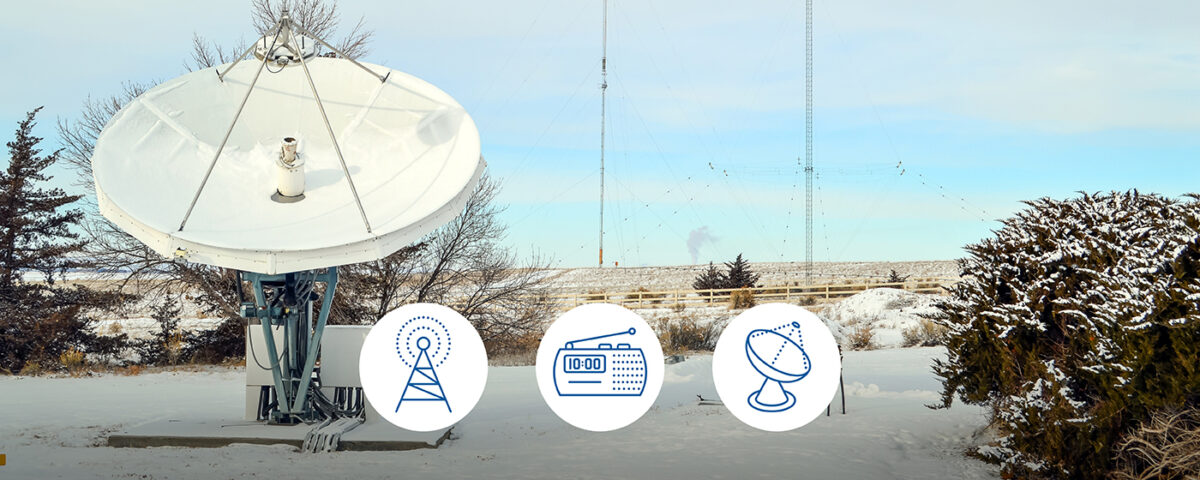If you still receive a printed bill in the mail, consider enrolling in Paperless Billing. Click for Benefits of Text & Email Notifications
×
If you’ve ever taken a trip down east country road 58, you’ve likely seen the large metal towers extending into the sky. Standing at roughly 400 feet, the towers are the tallest thing in the area for miles.
Many passersby have likely made guesses as to the purpose of these towering metal poles — are they for planes? Cell towers? Or maybe searching through space? Out here in Fort Collins, CO, the towers are actually for a much more specialized purpose: being the official source for accurate timekeeping for millions of North Americans.
The WWV & WWVB radio stations have been a part of the Fort Collins area since the 1960s. Chosen for its close proximity to the NIST (National Institute of Standards and Technology) in Boulder, the high ground conductivity due to the alkalinity of the soil, and its ideal distance from the mountains, the location of the stations allows for transmission of an omnidirectional signal, which communicates the time throughout the country with a received accuracy of fewer than 10 milliseconds.
But the history of WWV specifically extends well past their Fort Collins location. The station has existed since October of 1919, with its first official broadcast going on air in May of 1920 from the station’s original location in Washington, D.C. While originally airing evening concerts, WWV is one of the oldest commercial broadcast stations, and arguably the longest consistent running radio station ever (depending on how you define ‘consistent’). Since then, WWV has served a variety of purposes, emitted a variety of frequencies, and operated in a variety of locations before eventually finding its home here in northern Colorado.
Time stops for no one — so who’s around to do the timekeeping?
Inside a well-insulated building and surrounded by clocks, radio equipment, and transmitters originally designed by the navy for submarine communications sit the four WWV and WWVB staff members who keep things running. Among them are Matthew Deutch, electrical engineer, and Glenn Nelson, electronics technician, who together combine for 60 years of experience working at the stations.
“I was familiar with WWV in my early teen years,” Matthew said. “I had a shortwave radio, and I lived out in Longmont, and I could hear this time signal, and it was intriguing. I was a big shortwave listener to all the international radio broadcasts, and WWV was right in the middle of them on those bands.”
While Matthew and Glenn tend to predominately work inside these days, opting to maintain the internal systems, working on improving the signal, taking readings, and ensuring the time is still being transmitted accurately, the other two crew members do see frequent excursions up the 400ft towers surrounding the station grounds. Whether it’s for clearing off ice and snow or repairing parts damaged by high wind or lightning, climbing up the tower is a long process, and feeling the tower sway as you climb can certainly get the blood pumping. But the view from 400ft up can’t be beat.
Back inside WWVB, a workshop filled with parts and tools can be found. Back when the station was first built, a trip to town wasn’t as easy as it is now. If something went wrong, especially late at night or in the middle of a winter storm, it was imperative to have the tools and resources to make any necessary repairs. Further in, the sound of consistent whirrs and clicks of machinery running can be heard. There’s no shortage of electricity, heat, and moving parts here, and it all plays an integral role in keeping the time reporting consistent.
As we’ve shifted away from calling in to hear a man read off the current time to instead checking our phones, where does that leave WWV and WWVB?
As Matthew puts it, the stations can act as the “Poor man’s time stamp,” providing precise time measurements often used in scientific projects. The WWV and WWVB radio waves are also used to see how radio waves interact with the ionosphere. By studying how they hit the ionosphere and bounce back toward Earth, researchers can better understand how long-range radio communications are impacted by the ionosphere.
“There’s a lot of interest now in studying the ionosphere using the time signals,” Matthew said. “We broadcast across the six different frequencies and each frequency behaves differently. Every time we have a one-second tick, the amount of time it takes to go up through the ionosphere and back down varies, so people use those frequencies to better understand the ionosphere.”
Beyond the world of science, many HAM radio enthusiasts utilize the signal from WWV to keep their systems calibrated, experiment with swapping frequencies, or simply for the fun of catching the time readings.
If you’re interested in learning more about the WWV and WWVB radio stations, check out the Tune In: The WWV Frequency Celebration on March 2-4 at the Fort Collins Museum of discovery as they commemorate 100 years of standard frequency broadcasts. More information about the event can be found here: https://wwvarc.org/WWVFrequencyCelebration.